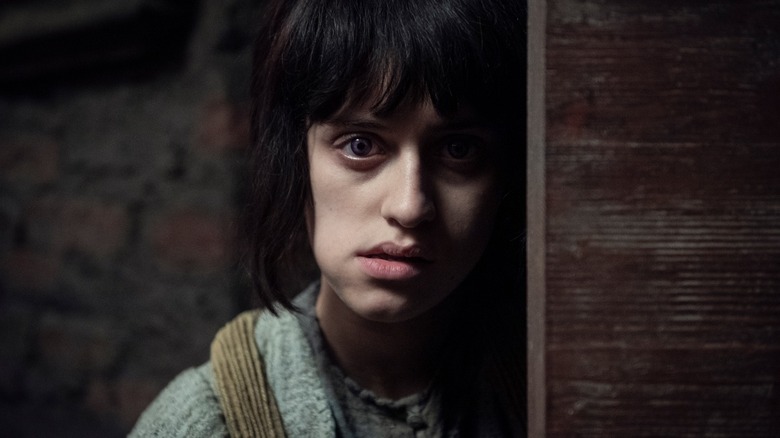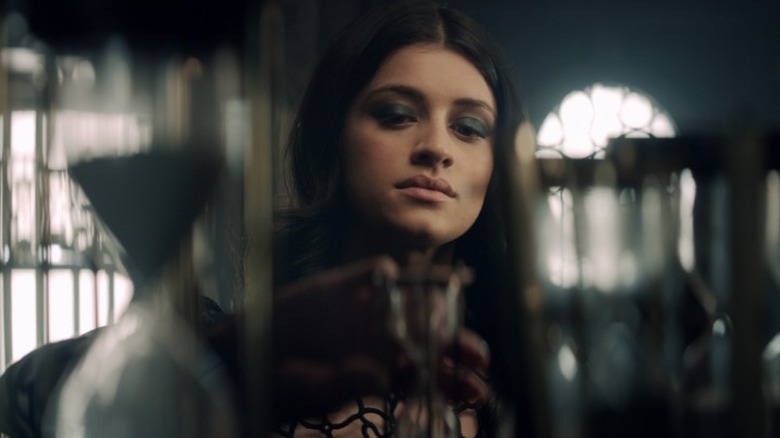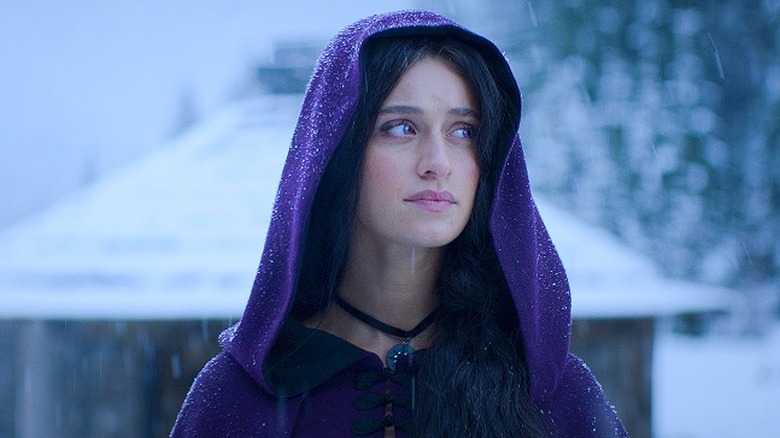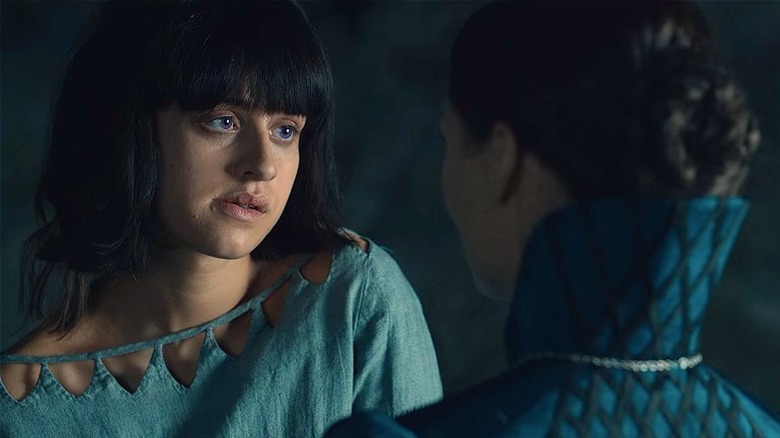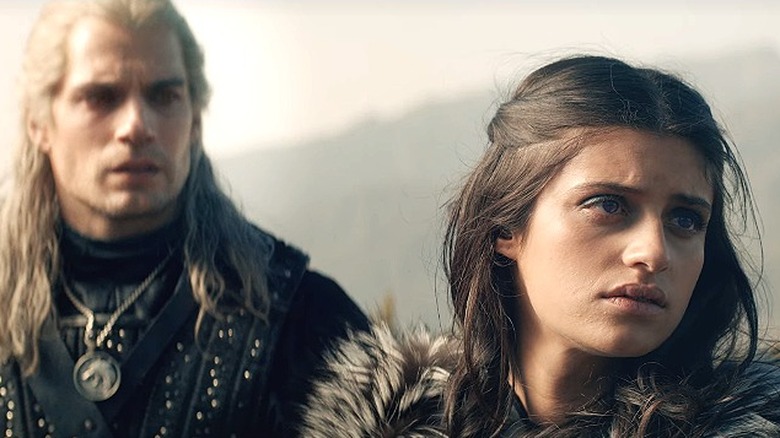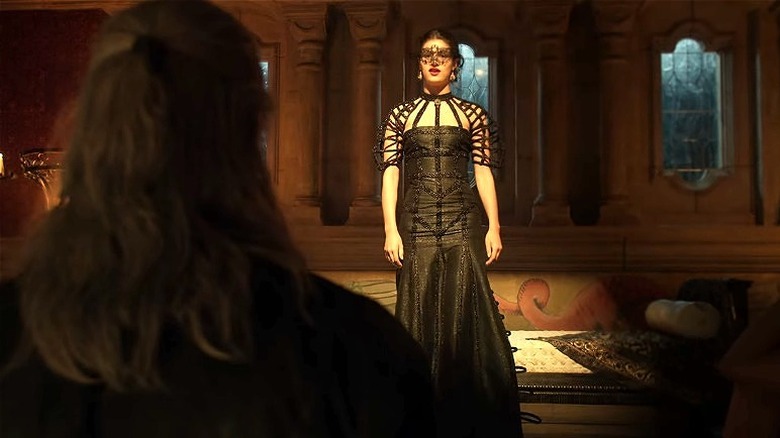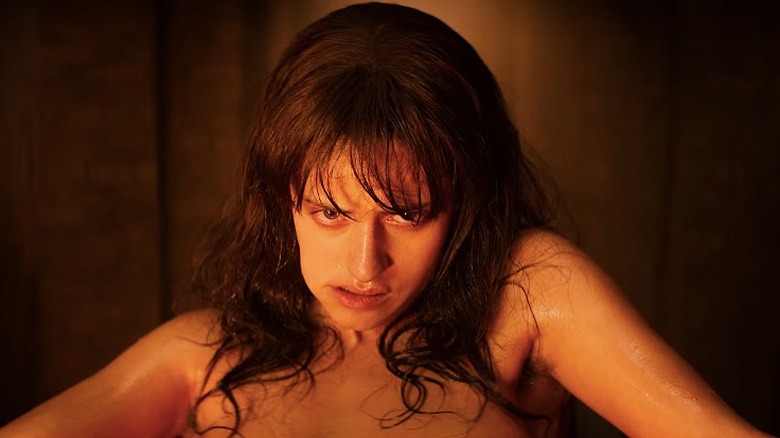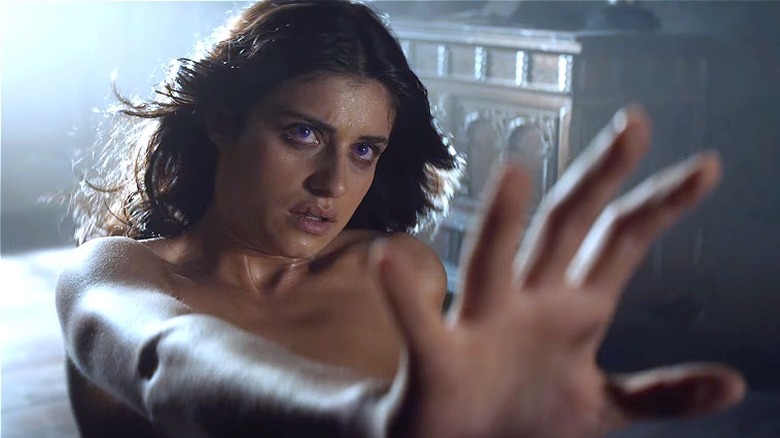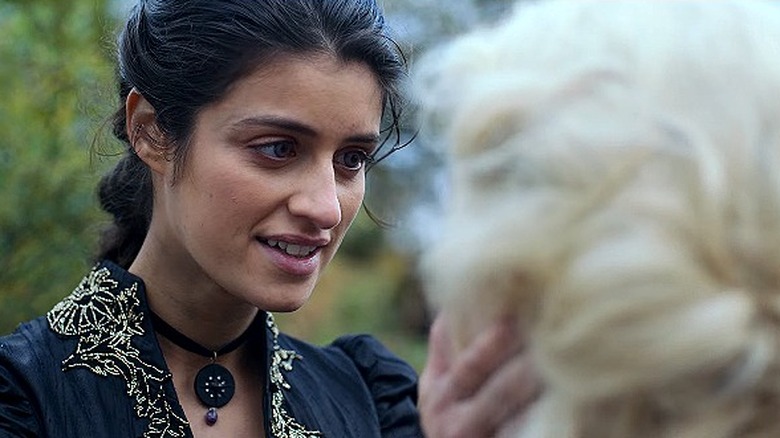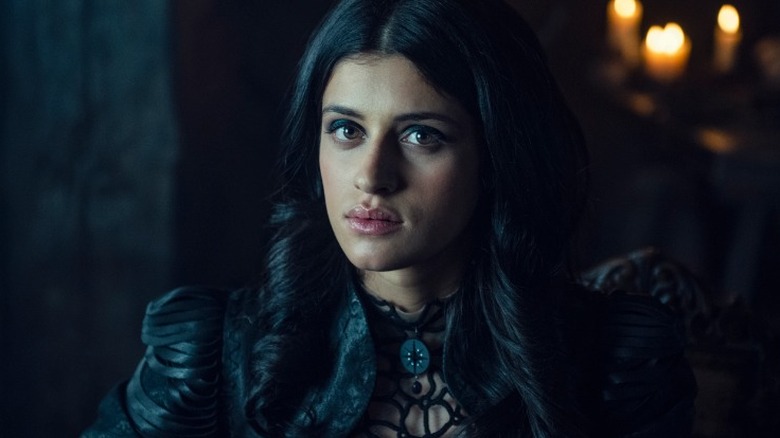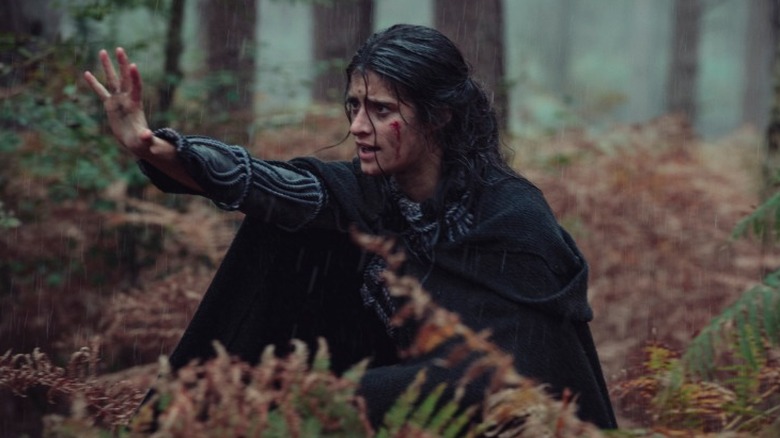Netflix's The Witcher Makes Yennefer Better Than Her Book Counterpart
Content warning: This article contains mentions of sexual assault.
If you're a fan of Andrzej Sapkowski, rest assured that the following is by no means a criticism of the author's globally-beloved epic. As "The Witcher" readers well-know, Sapkowski often actively acknowledges and subverts the casual-to-overt misogyny that has plagued the fantasy genre for (to put it lightly) a long time. In his spin on Arthuriana, two out of three main characters are women, his Holy Grail is a woman, and the issue of her bodily autonomy is an ongoing theme. Unlike so many of his genre peers, the award-winning author has no problem creating female characters with actual agency and depth.
That said — and as is so often the case in the real world — more than one thing can be true at the same time. In this case, the truths we're reconciling are thus: Sapkowski's novels give us numerous strong female characters, but at the same time, Lauren Schmidt Hissrich's adaptation gives us a more fully three-dimensional version of one particular character.
The reason for this is simple. Hissrich's Yennefer of Vengerberg (Anya Chalotra) serves a different purpose than Sapkowski's. In the books, Yennefer is a twist on the traditional "Guinevere" character (her very name is a combination of the original Welsh "Gwenhwyfar" and the Cornish iteration, "Jennifer"), a tool for moving the central Hero's Journey forward, and a means of illustrating Sapkowski's commentary on the mechanics and power of narrative. In the television series — and owing, in no small part, to both Chalotra's performance and the logistics of the medium itself — Yennefer is freed from the constraints of these responsibilities. It's both a functional and fundamental difference, and one that allows Hissrich to more fully flesh-out and foreground facets of the character to which the novels only ever allude.
Yennefer's improved characterization embodies the power of adaptation
Hissrich's Yennefer is, and isn't, a creation of adaptation. In some ways, she's exactly the character Sapkowski had mind — but not the one we get to meet on the page.
By Sapkowski's own admission, Yennefer exists chiefly to move along the story. Her reason for being is tied entirely to Geralt and Ciri's journeys — a function that makes it difficult to see her as a woman with motivations and emotional depth outside of her relationship to this man, this child, and the story's ongoing quest and theses. That said, Sapkowski is well aware that we're constantly seeing Yennefer through the eyes of others, and the lens of longstanding mythologies and traditions. In fact, he even lets us know that he — and Yennefer — are wise to her role in the surrounding narrative.
In "Blood of Elves," Yennefer confronts Dandelion (that's Jaskier) about his hyperbolic description of her in his ballads. "Who gave you permission to describe my internal organs?" Yennefer asks. "'Her heart, as though a jewel, adorned her neck. Hard as if of diamond made, and as a diamond so unfeeling, sharper than obsidian, cutting —' Did you make that up yourself? Or perhaps [...] you listened to someone's confidence and grievances?"
She's talking, of course, about Geralt. The source of narrative are an overarching theme in Sapkowski's work (even magic needs "a source"), and one from which few characters are immune. Here, Sapkowski is letting us know that the hot-tempered, manipulative, mercurial "bella donna" to whom we're introduced is a work of fiction, not just in our world, but in-world as well. The Netflix version is something deeper. Hissrich, in other words, hasn't given us the Yennefer of Sapkowski's lines, but the Yennefer that exists between those lines.
Yennefer's role in Sapkowski's novels is subversive
In the books, everything we know of Yennefer's life prior to her role in Geralt's and Ciri's comes from brief allusions to her past, none of which happen in real time. When we finally catch a glimpse into her childhood, it comes in the form of a truncated flashback in "The Tower of Swallows," the penultimate installment in the series. But Sapkowski waits until the final two books to give us deeper insight into the character for a reason.
For the better part of the saga, Yennefer is a common, (even ancient) "strong female character" trope. This classic SFC is not just proud, but irrationally and counter-productively indignant. She's not just intelligent, but manipulative and scheming. She's not just strong-willed, but a man-eater with a dash of dominatrix whose "flaws," if we can call them that, are that she struggles with domestic tasks. Yennefer can't even make preserves, though she's fond of throwing jars of them at Geralt. She is fiercely independent. She covets the one thing she can't have — a baby. Finally, her relationship with her father colors her entire existence. This trope is everywhere (see: Kelly Reilly's Beth Dutton, and every lead woman detective ever written), and can be found in some of humanity's earliest depictions of powerful women: one can be an Athena or an Aphrodite, but one cannot be both without being reduced to a kind of sexy madwoman.
Sapkowski uses Yennefer to draw attention to this longstanding trope and its implications, but to accomplish this, he first leans into it. Hissrich takes a different approach.
Yennefer's role in Hissrich's series is far more developed
In Hissrich's adaptation, Yennefer cast aside her "Sexy Nightmare Dreamgirl" handcuffs from the jump. We experience her beginnings alongside her, as the series meticulously stiches together the scraps of background from the novel to build an origin story that allows us to fully empathize with and relate to Yennefer's pain, pride, ambition, desire, and insecurity. Like any flesh-and-blood human, this Yennefer is a result of both nature and nurture, and a complex character whose flaws and missteps have real consequence, rather than a tool used to fulfill the archetypal, critical, and thematic needs of someone else's story. In Jaskier's (Joey Batey) eyes, she may be the same "very sexy, but insane witch" we meet early on in the novels, but for the viewer, she's something more.
In the books, we first meet Yennefer through Geralt's initial reading of her in "The Last Wish." In the series, although our introduction to her does involve her abusive father, it's her surrogate mother figure, Tissaia de Vries (MyAnna Burning) who is her most formative and defining relationship.
In "The Witcher: A Look Inside the Episodes," Hissrich describes Episode 2's Yennefer as fearful, and still on the way to gaining her power. As Yennefer grows, though, it's her love for Tissaia (and her lingering desire for Tissaia's approval) that compels her to fight at Sodden: this means that the maternal and filial love between two women is ultimately responsible for Nilfgaard's defeat. Not only does this relationship imbue both characters with more depth and complexity than their more casual relationship in the book, but it also provides some necessary foreshadowing regarding Yennefer's eventual relationship with Ciri (Freya Allen).
Geralt's Yennefer is not THE Yennefer
Before we dive into "The Witcher" series' betrayal that continues to enrage fans, let's return to our sorceress' dynamic with Sapkowski's subversive "white (haired) knight," Geralt of Rivia. As our entry into the narrative, it's Geralt who most closely resembles a reader proxy, and Geralt whose perspective and worldview most thoroughly informs our own in both the short stories and the epic's early installments. Our introduction to Yennefer in "The Last Wish" is no exception to the Geralt-colored-glasses rule, so it's no surprise that she emerges as a classic femme fatale. Her sole motivation for wanting to trap the Djinn is to gain direct access to chaos. In this story, Yennefer doesn't just speak. She hisses.
Again, in the books, this makes sense: we are seeing her through the eyes of a man who's instantly and involuntarily fascinated by this woman. In the series, though the plot of "The Last Wish" is followed faithfully in Season 1, Episode 5 — even lifting certain lines directly from the book — the viewer's focus is intentionally different.
In the books, Yennefer is touched — perhaps even changed — by Geralt using his last wish to bind her fate to his (presumably saving her from the Djinn's wrath), despite being somewhat confused by his dramatic sacrifice. She hears his wish when he makes it, and it's what prompts her to return his affection. In the series, Yennefer doesn't realize what Geralt (Henry Cavill) has done until they reunite (after he's abandoned her) in "Rare Species," and when she learns he's tethered them together through magic, she's furious.
The added real-world complexity of the Netflix Yennefer
And why shouldn't she be? Geralt may have saved her life, but did so by revoking an aspect of her free will. What's initially presented as a gallant gesture on the page would read as something else entirely in real life, particularly given Yennefer's anger in the series over the loss of another choice — that is, the choice to create life.
In the books, our first in-scene visual of Yennefer is of a nude, hungover sorceress rising out of bed and immediately using said nudity to manipulate Geralt. Yennefer may be just as in charge of her power over Geralt in the book as she is in the series, but the fact remains that we meet her body before we meet the woman herself. One might chock this up to a by-product of the medium (authors have to provide a visual, after all) were it not for the fact that almost every time Yennefer enters a scene, we're given a thorough run-down of her hair, eyes, lips, and body.
In the series, not only are we well acquainted with Yennefer prior to her meeting Geralt, but when he first lays eyes on her, she's fully clothed and has to step down to meet his gaze. Also missing from the series are the alternately violent and comedic fisticuffs that Yennefer and Geralt engage in prior to having sex, in which Yennefer's dress conveniently splits open. And yet, the series' depiction is no less sexually charged for its rejection of such James Bond-esque "foreplay."
Yennefer's body in the Witcher books
It's worth noting that, contrary to an often well-intentioned but essentially Puritanical assumption, the mere act of showing a woman's nude body isn't exploitative. Not every series makes the mistakes of "Game of Thrones," not every sex scene is reductive, and not every instance of female nudity is sexual. To suggest as much is to suggest that women's bodies are defined (wholly, and in a way that men's bodies are not), by the gaze and sexual intentions of the beholder. It is, in effect, to offer shame and blame in the guise of "respect" and "protection."
That said, there's a canyon of difference between depicting a woman with ownership over her body, and depicting a woman with (A) no real ownership or agency over her exposure (particularly if you're pretending to critique said exposure by reveling in it, as "The Idol" does), or (B), depicting a woman's body and sex appeal as her predominant source of power. Few fantasy series succeed in pulling off the former with as much conviction and awareness as "The Witcher," and the difference between how Yennefer's body is depicted in the books versus the series only further highlights this.
The books contain countless examples of Yennefer's body as an unwilling tool for the amusement or tantalization of others, but one particularly ugly instance occurs in "The Bounds of Reason." During the group's hunt for the dragon, the Reaver Boholt manages to tie Yennefer down, tear open her blouse, and threaten sexual assault. What's worse, the scene suddenly takes a "comedic" turn, via a joke from Dandelion, who is also trapped.
If you or anyone you know has been a victim of sexual assault, help is available. Visit the Rape, Abuse & Incest National Network website or contact RAINN's National Helpline at 1-800-656-HOPE (4673).
Yennefer's body in the Witcher series
It's all a far cry from how Yennefer's body is depicted in Season 1. The first time we see her nude, she's a willing, dominant participant so proud of her own sexual prowess that she conjures up an audience to applaud her performance. She also has yet to undergo her transformation. The second time we see her body, there's nothing sexual about it. It's shown during said transformation to highlight the painful sacrifice Yennefer is willing to make. Unlike in the books, Yennefer chooses to trade her ability to create life. This is why, later on, she'll repeatedly say that she "wants," "deserves," and is "owed" everything. When the payment is one's own bodily autonomy, the reward should be nothing less. The scene is also expertly intercut with another transformation: in one, a young woman cursed and rejected by the outside world and written off as a monster is violently transformed into something humanity no longer views as a threat to their safety; in the other, a striga is transformed back into a princess.
Finally, the third time we see Yennefer's nude body, it has nothing to do with seduction and everything to do with the mechanics of her spell. Her body is a source of power in the scene, and not merely a means of manipulation. In the books, she calls Geralt out: she sets a trap for him, and he falls for it. In the series, she calls Geralt out for something else. "You heroic protector," she says, "Noble dog. Permitting my success so long as you command it yourself." She's not entirely wrong, but her firm belief that anyone who offers assistance only does so as a means of control also infects her relationship with Tissaia.
Yennefer's relationship with Ciri
That world, as she puts it, is cruel. In order for Yennefer's evolution to make sense, she must start from a place from which she actually needs to evolve. Hissrich devotes almost an entire season to fleshing out and illustrating this baseline. It allows her to later grow through love and motherhood in a way that's both plausible and meaningful. And it requires an entirely different entry into said motherhood because (again) her character serves an entirely different purpose.
Fans had all sorts of reasons for hating Yennefer's Ciri storyline in Season 2, but a common complaint was that Yennefer's attempt to use Ciri for her own purposes ruined the endearing bond and dynamic they share in the books. So, let's discuss that bond.
In "Blood of Elves," Yennefer agrees to mentor Ciri for no other reason than that Geralt asks her to after both his, and Triss Merigold's, tutelages prove inadequate. Initially (or so we learn via flashback, and through Ciri's eyes) the women dislike each other largely because of their respective love for Geralt. Pretty immediately, this tension gives way to a stock mentor and mentee relationship that magically contains the perfect balance of playfulness and authority, stern wisdom and sardonic wit. Yennefer is an admirable and ideal mother figure despite having no experience with such a relationship (in the series, Tissaia's influence looms large in Yennefer's evolution with Ciri). Book Yennefer doesn't "grow" through her dynamic with Ciri; we simply get to see a side of her that exists inherently in all such women. And their bond — first and foremost — revolves around Geralt. "Suddenly we became close," Ciri recalls, "although I knew perfectly well that Geralt both brought us together and separated us, and that that's how it would always be."
Hissrich's reinterpretation of Yennefer makes sense with what we are allowed to see of her in the books
It's useless (and, let's face it, exhausting) to argue that fans who, for often understandable reasons, would rather see a regurgitation than an adaptation or reinterpretation should change their minds and appreciate the latter for what it is. At the same rate, it's unfair (and inaccurate) to judge the series' depiction of Yennefer — which is based on her function in the series — by a book depiction that results from her serving a wholly different function.
Hissrich's alternate use of Yennefer in no way defies the spirit and subtext of Sapkowski's work, nor is it all that uncommon for a change in medium to necessitate a change in characterization. In William Goldman's parodistic novel, "The Princess Bride: S. Morgenstern's Classic Tale of True Love and High Adventure," Buttercup is vastly different from her cinematic counterpart despite the fact that Goldman also wrote the screenplay for the film. In the books, Buttercup is a classic "dumb beauty," and Goldman uses her character — and Wesley's superficial attraction to her — as a comedic commentary on both damsels in distress and fairytale romance. By contrast, Robin Wright's Buttercup is no dummy, and the pair's love for one another is sincere. None of this changes the parodistic tone of the story. It's still delightfully absurd, and it still pokes fun at its literary tradition. Goldman simply changes the function of his lovers for the film, and with good reason.
Sapkowski's Yennefer is used, firstly, to forward Geralt and Ciri's plots, and secondly, to explore and exemplify the role of storytelling perspective and our mythologies by representing a number of female roles in those mythologies — roles well-known to Sapkowski as an obvious scholar of such traditions.
What is lost (and gained) from Yennefer's adaptation in Netflix's The Witcher
These roles are tweaked in various ways, but the sheer number of them speaks to the intentionality of Sapkowski's trope-promotion.
And to be fair, some of this function is lost in Hissrich's depiction. But it's no accident that this Yennefer is at her most courageous when she's at her (so-called) weakest, and without her magic — a plot that doesn't happen in the books. In losing Yennefer as a narrative tool and meta-commentary, we've gained something the fantasy genre has long struggled to provide: a Strong Female Character who truly lives up to the term. One with complexity, dimension, and depth who exists outside of her romantic and thematic affiliations. One who makes actual mistakes, and who must suffer and navigate the consequences thereof. One who is powerful, admirable, and relatable because of her vulnerability, doubt, fear, and weaknesses, all of which prompt her to persevere, triumph, and grow.
So, no, as many have pointed out, Hissrich hasn't faithfully portrayed Yennefer as she exists in the Witcher world of the books. Instead, she's portrayed her with the kind of strength that exists in our world.
"Imagine the most powerful woman in the world," Tissaia says to Yennefer in Season 1, Episode 3. Her next words are telling, and lets us know the exact change Hissrich has chosen to make: "Her hair, the color of her eyes, yes ... but also the strength of her posture. The poise of her entire being. Do you see her?"
Yennefer sees her. The viewer does not. Because an "entire being" isn't a fixed visual — nor something the mere reflection of something else can accurately depict, or adequately contain.
